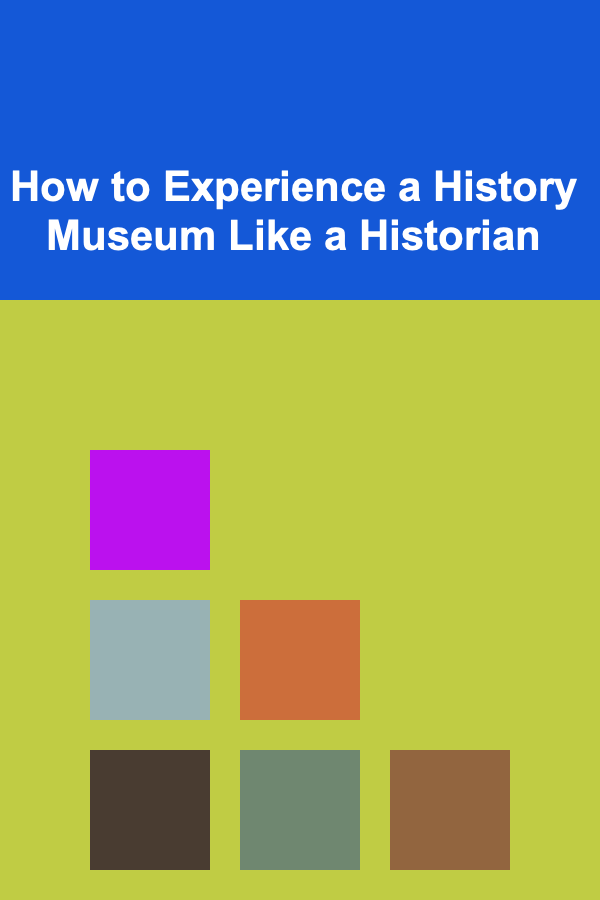
How to Experience a History Museum Like a Historian
ebook include PDF & Audio bundle (Micro Guide)
$12.99$6.99
Limited Time Offer! Order within the next:

Visiting a history museum can be a transformative experience, offering a glimpse into the past and allowing visitors to engage with history in a tangible, meaningful way. However, to truly appreciate the depth and significance of the exhibits, it requires more than just a casual stroll through the galleries. By approaching the museum with the mindset of a historian, you can deepen your understanding of the artifacts and narratives presented, uncover new layers of meaning, and connect with the stories they tell on a much more profound level.
In this article, we will explore how to experience a history museum like a historian---focusing on active observation, critical thinking, and reflection. We will cover key principles and techniques that historians use to analyze historical evidence and offer tips on how to engage more deeply with the exhibits, from examining artifacts with a critical eye to understanding the historical context in which they were created. With these strategies in mind, you can enrich your museum experience and develop a more nuanced understanding of history.
Preparation: Setting the Stage for Critical Engagement
Before you step into a history museum, it's important to take a few preparatory steps. The goal is to approach your visit with a sense of curiosity and a framework of knowledge that will allow you to engage with the exhibits on a deeper level.
Research the Museum and Its Collections
Just like historians, who carefully study historical sources before drawing conclusions, you can enhance your museum visit by learning about the museum itself. Many museums have websites or brochures that provide information on the themes, exhibits, and historical periods they cover. This gives you a roadmap to understand the context of the museum's collections.
- Museum Mission and Focus: What themes or periods does the museum focus on? For example, does it primarily explore ancient history, modern history, or specific geographical regions? Knowing this can help you navigate the exhibits more effectively.
- Current Exhibitions: Are there any temporary exhibitions or special collections being featured during your visit? These may provide insight into particular historical events or figures, offering opportunities for deeper engagement.
Understanding the museum's approach and objectives before you visit can set the stage for a more enriching experience. As you walk through the exhibits, you'll be more equipped to connect the pieces to broader historical narratives.
Familiarize Yourself with the Historical Context
While museums are filled with artifacts, they are also repositories of history. Understanding the broader context of the time periods, events, or cultures represented in the museum will allow you to interpret the artifacts with greater insight.
- Historical Background: Before visiting, research the historical events, cultural movements, or geographical regions represented in the exhibits. For instance, if the museum is focused on World War II, reading about the war's causes, major battles, and aftermath will provide a foundation for understanding the significance of the objects you'll see.
- Historical Sources and Perspectives: Consider what sources historians typically use to piece together historical narratives. Books, academic articles, documents, and primary sources are essential to building a nuanced understanding of any period. While a museum exhibit will offer a visual or material representation, knowing the history behind these objects will give them greater meaning.
Observation: How to Look at Artifacts Like a Historian
A historian's work is based on careful observation and analysis of evidence, and the same approach can be applied to museum artifacts. To engage with objects in a meaningful way, it's important to adopt a critical, analytical mindset when examining each item on display.
Examine the Object Closely
Historically-minded visitors approach each artifact with curiosity and precision. Take the time to truly look at the object, as if you were conducting a primary source analysis. Here are a few techniques for effective observation:
- Details: Look at the object from different angles. Pay attention to the materials, craftsmanship, colors, and any inscriptions. Each of these elements can provide clues about its origin, purpose, and the people who created it.
- Condition: Consider the state of the object. Is it well-preserved, or has it been worn down by time? The way an object is preserved---or deteriorates---can tell a story in itself. A historian might ask, "Why is this object in this condition? What does this tell me about the time period it comes from?"
- Size and Scale: Think about how the size of the object relates to its function. For example, a small, intricate tool may have been used for personal purposes, while a large, sturdy artifact may have served an industrial or communal role.
Look Beyond the Surface: What Stories Can Objects Tell?
Every object in a history museum is a piece of a larger narrative. To think like a historian, you need to ask questions and look beyond the surface level of the artifact. Here are a few questions you can ask:
- Who Made It? Consider the social, cultural, or political context of the artifact. Who created this object, and why? Was it produced by artisans, soldiers, everyday people, or political leaders? Understanding the maker's perspective can shed light on its significance.
- What Was Its Purpose? Objects are often designed with a specific function in mind. Was this artifact used in daily life, for ceremonial purposes, or in warfare? Understanding its purpose can help you contextualize it within the broader historical events it was a part of.
- What Does It Reflect About the Time Period? Every artifact tells a story about its time and place of origin. What does this object reveal about the cultural, economic, or political climate of the era? How does it reflect the values, beliefs, or struggles of the people who used it?
Contextualize the Object
Historians rarely look at an artifact in isolation---they always consider its relationship to other objects, people, and events. To deepen your understanding of an artifact in a museum, think about its context:
- Location and Time Period: Where and when was the object made? What was happening in the world at that time? An object from the Industrial Revolution, for instance, might tell you about the social and economic changes occurring in Europe during that period.
- Cultural Significance: What does the object tell you about the culture or society from which it originated? Objects like clothing, tools, or religious artifacts can offer a window into the daily lives, customs, and beliefs of a people.
By contextualizing an object in this way, you begin to see it not just as an isolated artifact, but as part of a larger historical narrative.
Interpretation: Drawing Meaning from Exhibits
Once you've examined the objects, it's time to interpret their meaning. This is where the historian's skills of analysis, synthesis, and critical thinking come into play. As you interpret the exhibits, it's important to engage with them on a deeper level, thinking about how they fit into broader historical narratives.
Question the Narrative
Museums often present a curated version of history, and while their exhibits are typically based on rigorous research, they can also reflect particular interpretations or biases. Historians know that history is not always straightforward, and different sources can offer conflicting views of the same event. When engaging with a museum exhibit, ask yourself the following:
- What Perspective Is Being Represented? Who created the exhibit, and what perspective do they bring to the presentation of history? Is there a dominant narrative that is being told, or are multiple perspectives included?
- Are There Gaps or Omissions? Consider what might be missing from the exhibit. Are there groups or viewpoints that are underrepresented? What perspectives might have been left out in the curation process?
By questioning the narrative, you can gain a deeper understanding of the complexities of history and the ways in which it is shaped and told.
Reflect on the Broader Implications
Finally, think about the broader implications of the objects and narratives you encounter in the museum. As a historian, you're always looking for patterns, connections, and larger trends that can inform your understanding of history. When reflecting on what you've learned, ask yourself:
- How Does This Relate to Contemporary Issues? History isn't just about the past---it can offer valuable lessons for the present. What can we learn from the events, people, or objects in the museum that might help us understand current issues?
- What Does This Object or Event Teach Us About Human Nature? One of the most powerful aspects of history is its ability to shed light on the human condition. What insights about human behavior, social dynamics, or cultural practices can you draw from the artifacts and exhibits?
By making these connections, you turn your visit into a reflective exercise that not only deepens your understanding of history but also allows you to apply its lessons to the present.
Engage with Museum Staff and Scholarly Resources
Historians engage in constant dialogue with other scholars, curators, and experts in their field, and you can do the same when visiting a museum. Museum staff, docents, and curators can provide valuable insights and answer questions that may deepen your understanding of the exhibits.
- Ask Questions: Don't hesitate to engage with museum staff. They are often experts in the field and can provide additional context or information about specific objects or exhibits.
- Use Available Resources: Many museums offer books, pamphlets, or digital resources that go beyond the basics of the exhibits. Explore these resources to gain a more comprehensive understanding of the history on display.
Conclusion
Experiencing a history museum like a historian requires more than just passive observation---it involves critical thinking, thoughtful analysis, and active engagement with the artifacts and narratives presented. By preparing yourself with historical knowledge, observing objects closely, interpreting their meaning in context, and reflecting on the broader implications, you can deepen your understanding of history and gain a more profound appreciation for the past.
The next time you visit a history museum, approach it as a historian would: with curiosity, critical thinking, and an open mind. The stories of the past are waiting to be uncovered, and with the right approach, you can connect with them in a way that is both meaningful and transformative.
Reading More From Our Other Websites
- [Home Budget Decorating 101] How to Hide Clutter Inexpensively and Keep Your Home Tidy
- [Organization Tip 101] How to Create a Home Inventory List for Insurance Purposes
- [Gardening 101] 10 Must‑Try Garden Wildlife Attractors to Turn Your Backyard into a Biodiversity Haven
- [Polymer Clay Modeling Tip 101] Best Methods for Creating Seamless Joint Lines in Polymer Clay Figurines
- [Home Cleaning 101] How to Choose and Use Eco‑Friendly Cleaning Products
- [Organization Tip 101] How to Use Shadow Boxes to Showcase Vintage Memorabilia
- [Home Security 101] How to Secure Sliding Glass Doors and Windows Effectively
- [Ziplining Tip 101] Soaring Peaks: A Beginner's Guide to Mountain Ziplining Adventures
- [Home Lighting 101] How to Use Lighting to Enhance Your Home's Color Palette
- [Organization Tip 101] How to Store Umbrellas Efficiently in Your Entryway

Eco-Friendly DIY Children's Toys and Games: Sustainable Fun for Kids
Read More
How to Choose the Best Pet Insurance for Your Pet's Needs
Read More
How to Sell Digital Products Successfully for Recruiters & HR Professionals
Read More
How to Set Up a Checklist for Managing Your Email Marketing Metrics: A Step-by-Step Guide
Read More
How to Grasp the Concept of Self: A Deep Dive
Read More
Finding Books That Play with Narrative Structure
Read MoreOther Products

Eco-Friendly DIY Children's Toys and Games: Sustainable Fun for Kids
Read More
How to Choose the Best Pet Insurance for Your Pet's Needs
Read More
How to Sell Digital Products Successfully for Recruiters & HR Professionals
Read More
How to Set Up a Checklist for Managing Your Email Marketing Metrics: A Step-by-Step Guide
Read More
How to Grasp the Concept of Self: A Deep Dive
Read More